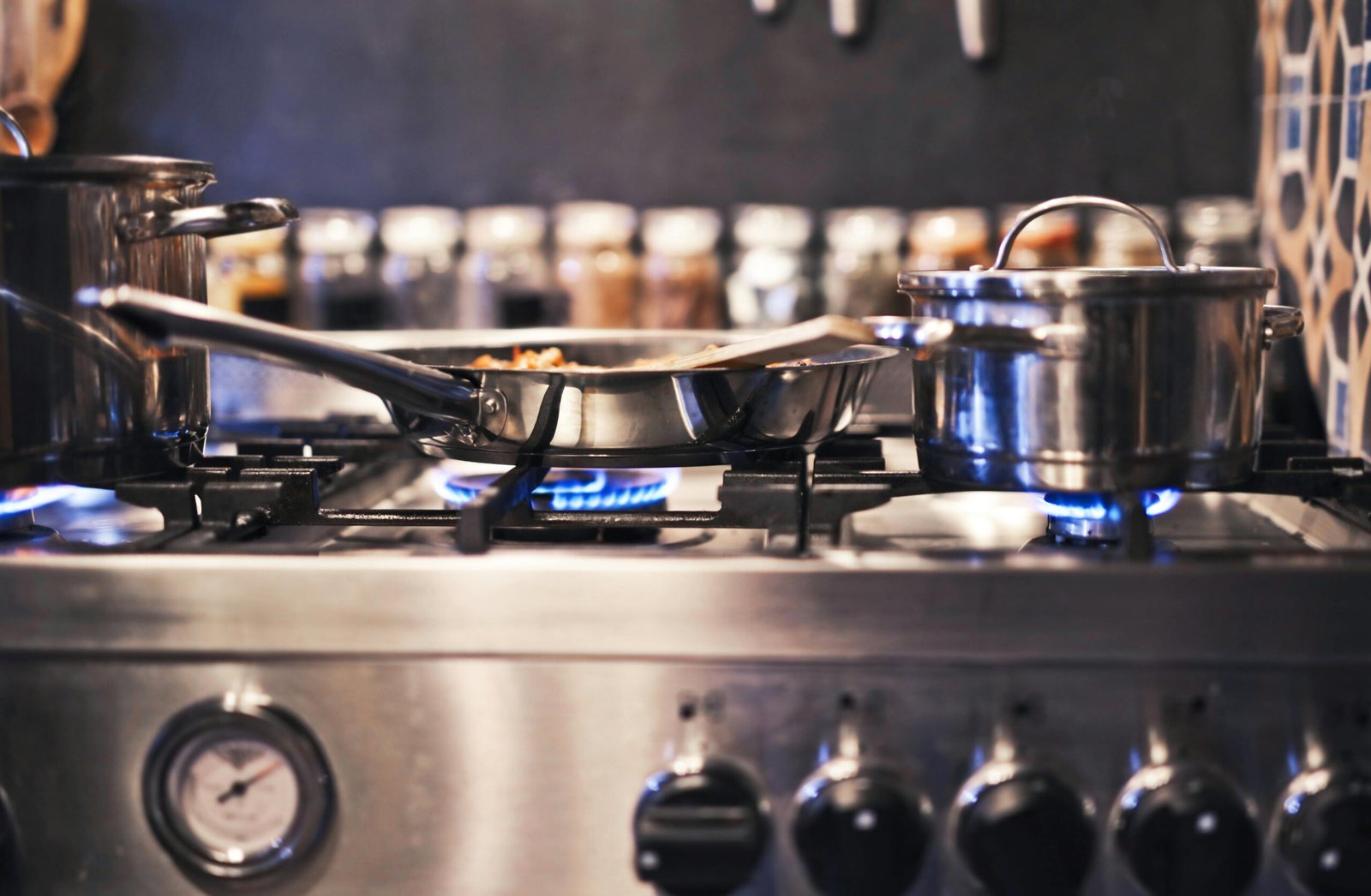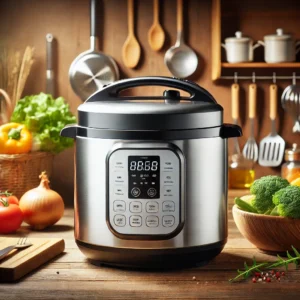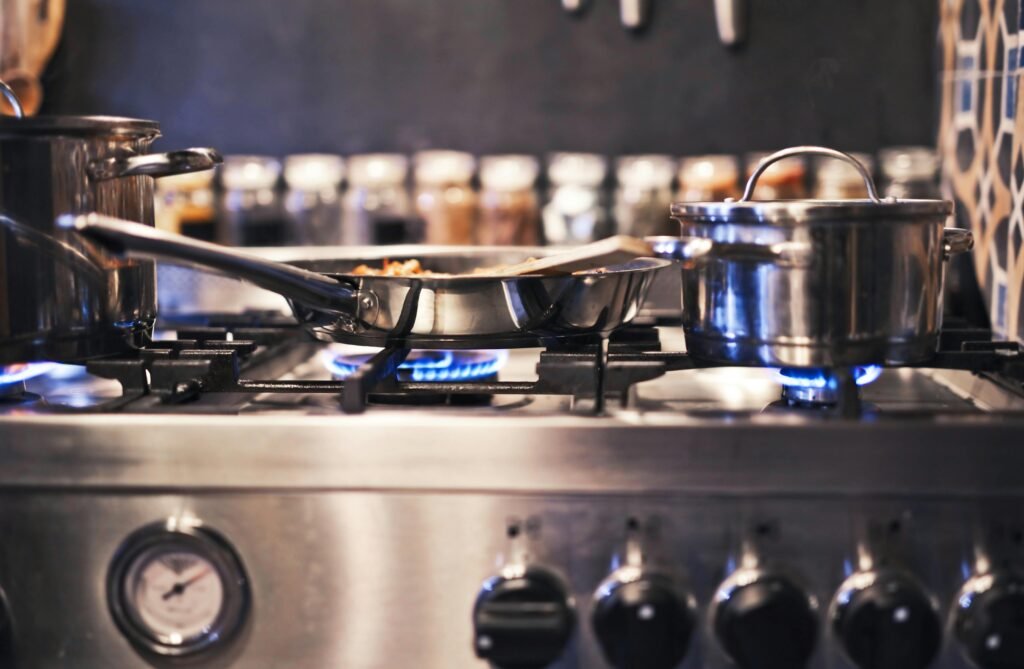
The best pots and pans for gas stove cooking are those that can withstand high heat, distribute heat evenly, and are durable enough to last for years to come.
In this guide, we will explore the top-rated pots and pans for gas stove cooking, to help you make an informed decision for your kitchen.
Best Pots and Pans for Gas Stoves, Highlighting Specific Features for Each Category:
Best Stainless Steel
Demeyere Atlantis
- Silvinox Surface Treatment: Prevents discoloration and maintains a shiny finish even when exposed to high heat.
- Thick Base: Designed to prevent warping, ensuring longevity and consistent performance.
- Efficient Heat Conduction: Perfect for the quick temperature changes of gas stoves, providing excellent cooking control.
Best Non-Stick
All-Clad HA1
- Hard-Anodized Aluminum Base: Offers durability and superior heat conduction.
- 3-Layer Non-Stick Coating: Ensures easy release and cleanup, ideal for daily cooking.
- Dishwasher Safe: Convenient for easy maintenance.
Caraway Nonstick Ceramic Cookware Set
- Ceramic Non-Stick Surface: Free from PTFE, PFOA, and other harmful chemicals, offering a healthy cooking option.
- Quick and Even Heating: Reduces cooking time and improves energy efficiency.
- Stylish Design: Available in multiple colors to match kitchen decor.
Best for Quick Heat Response
De Buyer Carbon Steel Cookware
- Rapid Temperature Change Adaptability: Ideal for recipes requiring precise temperature control.
- Requires Seasoning: Enhances natural non-stick properties over time.
- Durable Construction: Suitable for professional and home kitchens alike.
Best Ceramic
GreenPan Rio Ceramic Nonstick Cookware Set
- Thermolon Ceramic Non-Stick Coating: Eco-friendly and manufactured without harmful chemicals, offering a safe cooking surface.
- Warp-Resistant: Maintains shape and performance even under high temperatures.
- Oven-Safe Up to 350°F: Versatile for a range of cooking methods.
Best Copper Core
Legend Stainless Steel Copper Core
- Copper Core Encapsulated by Stainless Steel: Combines the excellent heat conductivity of copper with the rust resistance and durability of stainless steel.
- Even Heating: Ensures food cooks uniformly, reducing hot spots.
- Versatile Use: Suitable for various cooking techniques from searing to simmering.

Best Large Set
Cuisinart 17-Piece Cookware Set
- Aluminum Encapsulated Base: Ensures quick and even heat distribution.
- Stainless Steel Surface: Non-reactive with food and easy to clean.
- Complete Set: Includes everything needed for a fully equipped kitchen, from sauté pans to stockpots.
These features highlight the distinct advantages of each cookware set, helping you choose the right one for your cooking needs and preferences, especially tailored for use on gas stoves.
Understanding the Heat Dynamics of Gas Stoves
Gas stoves set themselves apart with their ability to quickly adjust from a high to a low temperature, making them a preferred choice for chefs and home cooks alike.
This unique characteristic necessitates the use of cookware that can not only handle the rapid changes in temperature but also promote even heat distribution.
The key to mastering gas stove cooking lies in understanding how these stoves transfer heat directly from the flame to the cookware.
Unlike electric stoves that heat the entire cooking surface, gas stoves concentrate the heat around the base of the pot or pan.
This means that cookware used on gas stoves needs to possess excellent heat retention and distribution properties to mitigate the direct flame’s intensity and prevent hot spots.
Materials that thrive on gas stoves include stainless steel, cast iron, and copper. Each of these materials interacts with the heat in a unique way.
For instance, stainless steel ensures durability and resistance to warping under high temperatures, making it a reliable choice for the fluctuating heat of gas stoves.
Cast iron, renowned for its heat retention, gradually absorbs heat and distributes it uniformly, cooking food evenly. Copper stands out for its superior conductivity, allowing for precise temperature control – a valuable trait when dealing with the direct heat of a gas flame.
Furthermore, the construction of the cookware is also paramount. Pots and pans with thicker bases benefit from the gas stove’s direct heat source, as they absorb and distribute the heat more evenly, preventing the formation of hot spots that could lead to uneven cooking or burning.
Understanding the dynamics of how gas stoves heat cookware is essential for selecting the right materials and construction that will lead to optimal cooking results.
This foundational knowledge ensures that chefs and home cooks alike can make informed decisions about their cookware, leading to better culinary experiences.
The Importance of Material in Your Cookware Choices
Selecting the correct material for your cookware is pivotal when cooking on a gas stove. The material not only affects the cookware’s performance but also influences the flavor and outcome of the food.
Among the preferred choices, stainless steel stands out for its robustness and ease of maintenance. Its non-reactive nature ensures that acidic foods can be cooked without fear of altering the flavor or appearance.
On the other hand, cast iron boasts unparalleled heat retention capabilities, making it ideal for slow cooking and searing at high temperatures. Its ability to maintain heat helps in cooking food evenly, enhancing the flavors and textures of the dishes.
Copper cookware, although less commonly used due to its higher price point, offers exceptional heat conductivity.
This feature allows for quick and even heating, providing cooks with precise temperature control. This is particularly beneficial when preparing delicate sauces or foods that require consistent temperatures to avoid overcooking. However, copper cookware often requires a bit more maintenance to keep its shine and prevent tarnishing.
Additionally, the advent of multi-clad materials has revolutionized cookware for gas stoves. These are often constructed with a core of aluminum or copper sandwiched between layers of stainless steel, combining the best properties of each material.
The result is cookware that heats up quickly, distributes heat evenly, and is durable and easy to clean. The multi-layered construction also mitigates the issue of hot spots, common in single-material cookware, ensuring an even cooking surface.
It’s also worth noting that the compatibility of the material with other kitchen tools is an aspect to consider.
For instance, certain non-stick surfaces may not be suitable for use with metal utensils, and some materials require specific cleaning methods to prevent damage.
Therefore, when selecting cookware for a gas stove, considering how the material aligns with your cooking habits and kitchen practices is crucial for long-term satisfaction and culinary success.
Why Heavy-Bottomed Pots and Pans Reign Supreme
In the realm of gas stove cooking, the superiority of heavy-bottomed pots and pans cannot be overstated. The essence of their dominance lies in their robust construction, featuring thick bases that play a crucial role in the culinary process.
These hefty foundations are adept at absorbing the direct flame’s energy, facilitating an even distribution of heat across the cooking surface.
This uniform heating is pivotal in preventing the dreaded hot spots, notorious for causing uneven cooking or, worse, burning certain sections of the meal while leaving others underdone.
The benefits of heavy-bottomed cookware extend beyond mere heat distribution. Their substantial nature also contributes to stability on the burner, minimizing the risk of tipping or spinning, which can be especially valuable when stirring or flipping contents requires a bit of vigor.
Furthermore, the weight and material of these pots and pans contribute to their overall heat retention, allowing for a more controlled cooking experience.
This aspect is particularly beneficial when simmering sauces or maintaining a steady sear on proteins, where precise temperature management is key to achieving the desired culinary outcome.
Interestingly, the advantages of heavy-bottomed cookware resonate with a variety of materials, each bringing its unique strengths to gas stove cooking.
Whether it’s the enduring heat conduction of stainless steel, the exceptional heat retention of cast iron, or the rapid responsiveness of copper, a hefty base enhances these inherent material benefits.
This synergy between material and construction means that chefs and home cooks can select cookware that not only suits the specific demands of their recipes but also maximizes the efficiency and effectiveness of their gas stove.
In the bustling environment of a kitchen, where the dance between flame and food is both an art and a science, heavy-bottomed pots and pans emerge as indispensable tools.
They bridge the gap between the raw potential of a gas flame and the nuanced control required for culinary excellence, affirming their reign in the world of gas stove cooking without the need for repetitive emphasis on their foundational significance.

The Top Brands for Gas Stove Cookware
Navigating the myriad of cookware brands suitable for gas stoves can be overwhelming, yet a few names consistently stand out due to their commitment to quality, durability, and performance.
All-Clad is often celebrated by both professional chefs and home cooks for its multi-clad stainless steel pots and pans that ensure even heat distribution and superb heat retention, critical for the direct flame cooking of gas stoves.
Their products are renowned for a balance of durability and cooking excellence, making them a worthy investment for any serious cook.
Le Creuset, another heavyweight in the realm of cookware, offers a range of enameled cast iron cookware that is as beautiful as it is functional.
Their Dutch ovens and skillets are ideal for a gas stove, providing unparalleled heat retention and the versatility to go from stovetop to oven with ease.
The vibrant colors and timeless design of Le Creuset pieces also make them a statement item in any kitchen.
Calphalon and Cuisinart are brands that cater to a wide range of culinary needs, offering everything from hard-anodized nonstick pans to stainless steel cookware sets.
Calphalon is particularly noted for its innovative nonstick surfaces and hard-anodized aluminum construction, which provides quick and even heating suitable for the dynamic nature of gas stove cooking. Cuisinart, on the other hand, offers a plethora of cookware options that blend functionality with affordability, making professional-grade cookware accessible to home cooks.
Their stainless steel collections are especially well-regarded for gas stove use, thanks to the even heat distribution and robust construction.
Choosing cookware from these reputable brands means investing in pieces that will not only perform excellently on a gas stove but also endure the rigors of daily cooking, affirming their place as top contenders in the search for the best pots and pans for gas stove owners.
Must-Have Pots and Pans for Gas Stove Owners
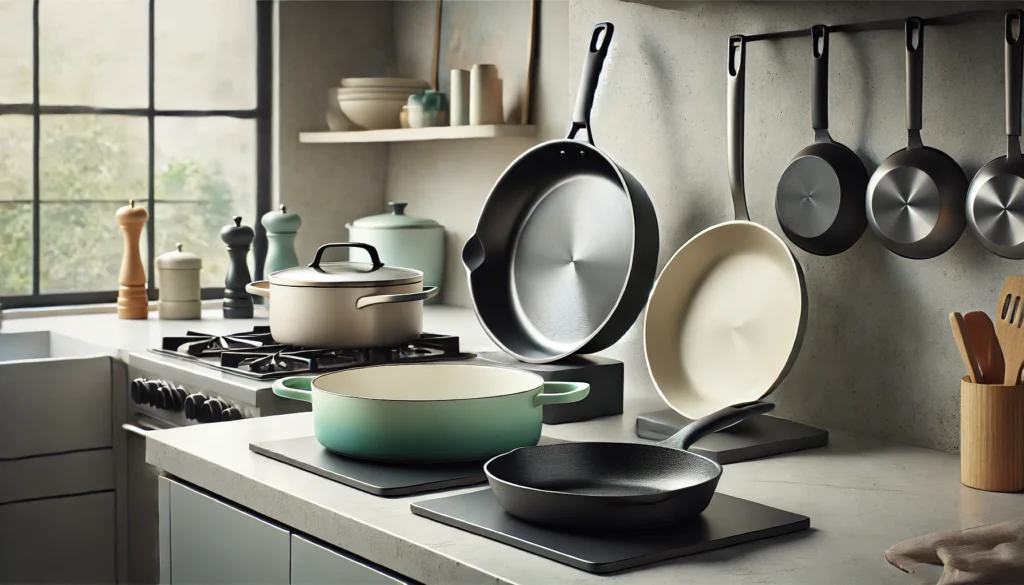
For those who use gas stoves, equipping your kitchen with the right cookware is crucial.
A well-rounded set begins with a durable stainless steel skillet, known for its versatility and resilience against the fluctuating temperatures of gas cooking.
This skillet becomes indispensable for everything from searing meats to gently sautéing vegetables.
Another essential is a cast iron Dutch oven, which excels in heat retention and distribution, making it perfect for slow-cooking stews, baking bread, or even deep-frying.
Its ability to move seamlessly from stovetop to oven makes it a valuable asset for complex dishes that require both cooking methods.
A heavy-bottomed saucepan rounds out the trio of must-haves. Ideal for sauces, boiling pasta, or cooking grains, its thick base ensures even heat without the worry of scorching, a common issue on the concentrated flames of a gas stove.
These saucepans often come with a tight-fitting lid, essential for simmering or cooking dishes that require a controlled steam environment.
In addition to these foundational pieces, a non-stick frying pan can also be beneficial for delicate tasks like cooking eggs or pancakes, where easy food release and cleanup are priorities.
Opting for one with a sturdy, heat-resistant handle and a compatible lid will add even more functionality to your cookware collection.
Investing in these key pieces of cookware will not only elevate your cooking game but also allow you to explore a broader range of culinary techniques with confidence.
Each item has been chosen for its ability to perform exceptionally on the gas stove, ensuring that you have the right tools at hand to tackle any recipe with ease.
Specialized Cookware for Advanced Gas Stove Cooking
For the ambitious home chef looking to expand their culinary capabilities on a gas stove, exploring specialized cookware is a thrilling next step.
Each piece of specialized equipment is designed to enhance certain cooking techniques, opening up new possibilities for flavor and presentation that standard cookware cannot achieve.
A prime example is the carbon steel wok. Its unique, deep, rounded shape and responsive material make it perfect for high-heat, fast-cooking techniques essential to authentic stir-frying.
The wok’s design allows for quick tossing of ingredients without spillage, ensuring even cooking and optimal heat distribution at the intense temperatures required for searing meats and vegetables to perfection.
Investing in a high-quality copper sauté pan is another way to elevate your cooking.
Copper’s exceptional thermal conductivity allows for precise temperature control, making it ideal for tasks requiring sensitivity to heat changes, such as creating delicate sauces or perfectly seared proteins.
This level of control can transform the outcome of dishes, providing an unparalleled culinary experience.
For those looking to achieve the ultimate in non-stick performance without sacrificing safety or quality, a ceramic-coated nonstick skillet offers a modern solution.
These pans provide an eco-friendly, chemical-free non-stick surface, ideal for cooking fragile dishes like fish or eggs that benefit from gentle handling and minimal oil.
These specialized pieces not only enhance the cooking experience but also encourage the exploration of diverse cuisines and techniques.
They represent a commitment to culinary craft, pushing the boundaries of what can be achieved on a gas stove.
As you grow in your cooking journey, embracing these tools can help unlock the full potential of your ingredients and recipes, bringing professional-grade results into your home kitchen.
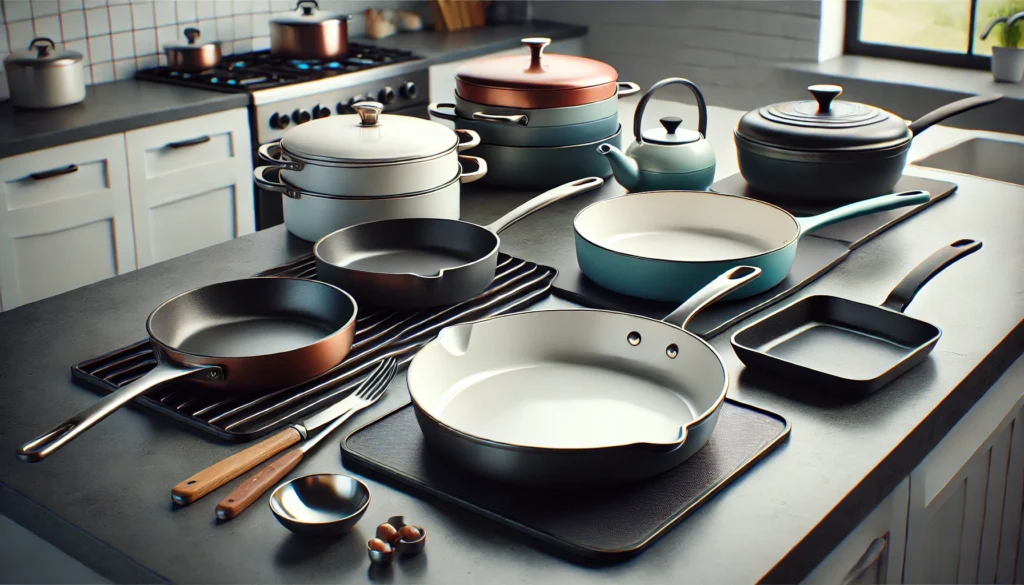
Caring for Your Gas Stove Cookware
Maintaining your cookware in pristine condition is vital for extending its lifespan and preserving its cooking efficiency, especially when used on gas stoves.
Proper care involves gentle cleaning practices and appropriate storage. After use, allow the cookware to cool before washing to prevent warping.
Use a soft sponge or cloth and mild detergent to clean, avoiding harsh scouring pads that can scratch surfaces, particularly for non-stick and stainless steel items.
For those with cast iron pieces, it’s crucial to avoid soaking them in water. Instead, clean them while they’re still slightly warm using a brush and hot water.
Immediately dry them thoroughly to prevent rust. Applying a light coat of vegetable oil after cleaning will help maintain the seasoning and protect the surface.
If rust does appear, gently scrub the spot with a mixture of salt and cooking oil to remove it, then reseason the pan.
Copper cookware requires a bit more attention to maintain its luster and prevent tarnishing.
A natural cleaner like lemon and salt can be effective for restoring its shine without using harsh chemicals. Rinse and dry these pieces immediately after washing to prevent water spots.
When storing your cookware, avoid stacking pots and pans directly on top of each other, as this can lead to scratches and wear, especially for non-stick surfaces.
If space necessitates stacking, placing a layer of soft cloth or paper towels between each item can offer protection against damage.
Remember, investing a little time and effort into the care of your cookware not only preserves its functionality and appearance but also ensures that it remains a reliable tool in your culinary adventures on your gas stove.
The Role of Cookware in Culinary Success
Choosing the right cookware is not just about filling your kitchen with tools; it’s about equipping yourself for culinary excellence.
The materials, construction, and compatibility of pots and pans with a gas stove directly influence your cooking.
High-quality cookware acts as a bridge between your culinary skills and the meals you envision, turning ordinary ingredients into extraordinary cuisine.
For gas stove cooking, the responsiveness and heat distribution of your cookware can make or break a dish. Imagine searing a perfect steak, simmering a delicate sauce, or crafting a comforting stew—each of these tasks requires cookware that can handle the unique characteristics of a gas flame.
Cookware that provides even heat distribution and maintains optimal temperatures will ensure that your dishes are cooked uniformly, enhancing flavors and preserving nutrients.
Furthermore, the right cookware can inspire confidence and creativity in the kitchen.
Knowing that your pots and pans can withstand the rigors of gas cooking allows you to experiment with new recipes and techniques without fear of damaging your equipment.
This confidence can lead to more adventurous cooking, introducing you and your loved ones to a world of culinary possibilities.
Investing in the best pots and pans for gas stove cooking is not just a practical decision—it’s a commitment to your culinary journey.
High-quality cookware not only improves the efficiency of your cooking process but also contributes to the overall enjoyment of meal preparation.
Whether you’re crafting a simple weeknight dinner or preparing a feast for a special occasion, the right cookware ensures that every dish you create is a testament to your dedication to cooking excellence.
In essence, the cookware you choose is a reflection of your culinary aspirations. It empowers you to explore the art of cooking in its fullest expression, turning your kitchen into a canvas for creativity and flavor.
As you continue to grow and evolve as a cook, your cookware becomes an essential partner in the pursuit of culinary success, making every meal a celebration of your passion for cooking.
Related Articles:
A Sneak Peek into the Features of the Best Dishwasher 2024
A Detailed Review: The Winner of the Knife Set Showdown
As an Amazon Associate, I earn commission from qualifying purchases.

